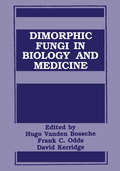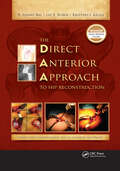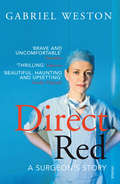- Table View
- List View
Dimethyl Sulfoxide (DMSO) in Trauma and Disease
by Stanley W. Jacob Jack C. de la TorreFirst isolated as a chemical compound by a Russian chemist in 1866, dimethyl sulfoxide (DMSO) proved to be a near-perfect solvent for decades before its remarkable biological and medical activities were discovered. DMSO is one of the most prodigious agents ever to come out of the world of drug development. Its wide range of biological actions invol
Diminished Ovarian Reserve and Assisted Reproductive Technologies: Current Research and Clinical Management
by Orhan BukulmezThis book brings together the most current research and the latest clinical approaches to the management of diminished ovarian reserve (DOR), one of the largest segments of the IVF patient population, both in the advanced reproductive age group as well as poor responders. Opening with a review of the definition and scope of the problem, as well as the current understanding of the natural history of DOR, subsequent chapters in part I outline dietary, hormonal, traditional supplements and conventional methods used to stimulate ovaries and improve ART outcomes. The main segment of chapters, comprising part II, present minimal and mild stimulation protocols and alternatives, frozen embryo transfer preparation, trigger agents and post-trigger testing, embryo culture and endometrial considerations, and a review of clinical outcomes. Part III discusses the utilization of contemporary technologies in the treatment of DOR, including fresh vs. frozen embryo transfer, cryopreservation and comprehensive chromosomal analysis. Future prospects are presented in part IV, such as the artificial oocyte and ovary development, early-age oocyte freezing, ovarian cortical tissue freezing and activation of the ovarian cortex. Utilizing the latest evidence and authored by an international array of thought leaders, Diminished Ovarian Reserve and Assisted Reproductive Technologies is an excellent resource for reproductive medicine and REI specialists, IVF lab professionals, and students and residents in these areas.
Dimorphic Fungi in Biology and Medicine
by D. Kerridge F. C. Odds Hugo Vanden BosscheFungal dimorphism is a topic that sounds inherently too rarified to attract more than a specialist audience. Yet some 230 individuals representing an eclectic mixture of interests, from basic science to medical practice, gathered in Churchill College, Cambridge in Semptember 1992 for a meeting devoted only to this subject. The symposium was the fourth in a series "Topics in Mycology" to be jointly organized by the Janssen Research Foundation and the International Society for Human and Animal Mycology. The participants enjoyed a rich and varied diet of oral presentations and poster displays in the field of fungal morphogenesis. This book sets down in print the material presented at the dimorphism symposium. We think that the high quality of these papers conveys very well the flavor of what was an excellent meeting. The selection of contributions in this volume covers very wide ground indeed. Chapters devoted to some non-pathogenic fungi are included, because the scientific basis of morphological development belongs to the fields of cellular and molecular biology: it does not recognize the boundary imposed by considerations of virulence of a fungus for a human host. Yet morphogenetic change in those fungi that do cause human disease frequently appears to be a component of the pathological process: many important pathogens change from a hyphal form in the external environment to a round form in infected tissues. This relationship between dimorphism and pathogenicity is the point of contact between pure biology and medicine.
Dioxin Perspectives: A Pilot Study on International Information Exchange on Dioxins and Related Compounds (Nato Challenges of Modern Society #16)
by Erich W. Bretthauer Heinrich W. Kraus Alessandro Di DomenicoErich W. Bretthauer, Chairman of the Exposure and Hazard Assessment Working Group U. s. Environmental Protection Agency Washington, D. C. The efforts of the Exposure and Hazard Assessment Working Group were focused on the exchange of information on a variety of topics including research projects, regulations/statutes, analytical laboratories, and methods of exposure/risk assessment involving CDDs and CDFs. It was evident to the leaders of the Working Group that several of the knowledge voids had to be addressed on a fundamental level before expanded efforts could be made. Several questions needed to be answered: • Who has done research on this topic, and what do the data indicate? • Who is performing research now, and what are their capabilities? • How are other nations addressing this problem, and do they have legislative mandates in place? • Is there a general consensus on the topic? The members of the Working Group believed that these questions could be answered by surveying the major participants in the field of interest. Three principal survey efforts were performed by the Working Group, which collected information on research, regulations/statutes, and analytical laboratories from each of the participating nations. In addition to answering these fundamental questions, these efforts also fulfilled the major objectives of the entire Pilot Study. The collection, analysis, and distribution of information on research projects, regulations/statutes, and analytical laboratories were very useful efforts in helping to fill some of the basic knowledge voids.
Dipeptidyl Aminopeptidases: Basic Science and Clinical Applications
by Uwe Lendeckel Dirk Reinhold Ute BankThis is the first comprehensive volume on Dipeptidyl Aminopeptidases that can be marketed to a wide variety of disciplines, as well as to a variety of clinicians. Leading experts in the field contribute to this state-of-the-art view on these enzymes. This book comes at a time when our understanding of their function is growing ever more rapidly and therapeutic options have become imminent.
Dipeptidyl Aminopeptidases in Health and Disease (Advances in Experimental Medicine and Biology #524)
by Martin Hildebrandt Hans-Ulrich Demuth Torsten Hoffmann Burghard KlappProceedings of the International Conference on Dipeptidyl Aminopeptidases, held September 26-28, 2002, in Berlin, Germany. Dipeptidyl Aminopeptidases exert a potent modulatory role at an interface between immune mechanisms, metabolic responses and neuroendocrine pathways. Experimental models and clinical studies addressing the role of these enzymes and the effect of specific inhibitors pave the way to novel therapeutic concepts in immunology, rheumatology, oncology, reproductive medicine and diabetes. Leading experts in this field have contributed to this book which presents a state-of-the-art view on these enzymes, at a time when our understanding of their function is growing ever more rapidly and therapeutic options become imminent. The sections of the book focus on various topics: - Structure and function of dipeptidyl aminopeptidases, - DPP IV-like proteins, - Immune mechanisms and immune disorders, - Cancer and angiogenesis, - Diabetes and metabolism, - Therapeutic implications.
Diphtherie und Anginen: Band 4 (Bücher der ärztlichen Praxis #4)
by Carl Leiner Felix BaschDieser Buchtitel ist Teil des Digitalisierungsprojekts Springer Book Archives mit Publikationen, die seit den Anfängen des Verlags von 1842 erschienen sind. Der Verlag stellt mit diesem Archiv Quellen für die historische wie auch die disziplingeschichtliche Forschung zur Verfügung, die jeweils im historischen Kontext betrachtet werden müssen. Dieser Titel erschien in der Zeit vor 1945 und wird daher in seiner zeittypischen politisch-ideologischen Ausrichtung vom Verlag nicht beworben.
Diploma in Dental Nursing, Level 3
by Carole HollinsDiploma in Dental Nursing, Level 3 is the new edition of the must-have study companion for trainee dental nurses preparing for the City & Guilds Level 3 Diploma in Dental Nursing (formerly NVQ). The book offers comprehensive support on the units assessed by portfolio - from first aid and health and safety to specific chairside support procedures - as well as the four areas of the course tested by multiple choice questions: infection control, oral health assessment, dental radiography and oral health management. This third edition of an established revision text has been substantially revised and restructured in line with the new qualification and reflects changes in the regulations and legislature affecting dentistry and dental workplaces, all of which have an effect on the daily role and working life of the dental nurse. It will be an invaluable guide for dental nurse trainees, qualified dental nurses and course providers. - Expanded and revised, with extensive coverage of the fifteen Diploma units- In full colour throughout with over 400 illustrations- Companion website with downloadable glossary and MCQs for revision and self-assessment
Diploma in Dental Nursing, Level 3
by Carole HollinsDiploma in Dental Nursing, Level 3 is the new edition of the must-have study companion for trainee dental nurses preparing for the City & Guilds Level 3 Diploma in Dental Nursing (formerly NVQ). The book offers comprehensive support on the units assessed by portfolio - from first aid and health and safety to specific chairside support procedures - as well as the four areas of the course tested by multiple choice questions: infection control, oral health assessment, dental radiography and oral health management. This third edition of an established revision text has been substantially revised and restructured in line with the new qualification and reflects changes in the regulations and legislature affecting dentistry and dental workplaces, all of which have an effect on the daily role and working life of the dental nurse. It will be an invaluable guide for dental nurse trainees, qualified dental nurses and course providers. - Expanded and revised, with extensive coverage of the fifteen Diploma units- In full colour throughout with over 400 illustrations- Companion website with downloadable glossary and MCQs for revision and self-assessment
Diplomacy and Negotiation for Humanitarian NGOs (Humanitarian Solutions in the 21st Century)
by Larry Winter Roeder, Jr. Albert Simard Diplomacy and Funding for Humanitarian Non-Profits is a practical guide to best practices in diplomacy and negotiation for non-profits (NGOs) who work to convince governments and international institutions to effectively protect humans through disaster assistance, sustainable development and the protection of cultures. The volume proposes a holistic approach to humanitarian assistance by integrating non-traditional and traditional humanitarian partners. Users of the book will be prepared to speak to diplomats and government officials in any setting, including war zones. The book mainly focuses on approaching local and national governments, the United Nations system, the international Red Cross movement and other international organizations. The reader will learn the rules of “diplomatic protocol", and much about the rules and procedures of major international bodies, as well as how to leverage media and knowledge management for planning, establishing, and managing a humanitarian initiative. To provide balance and real world relevance, the guide draws on a compilation of the extensive activities of both authors across a range of development, emergency management, knowledge management, and climate issues in government and in the NGO world, as well as interviews with a broad range of scholars and officials from NGOs, diplomatic missions, the media, the United Nations, the Red Cross, governments and corporations.
Direct and Inverse Methods in Radar Polarimetry (Nato Science Series C: #350)
by W. M. Boerner Leonard A. Cram William A. Holm David E. Stein Werner Wiesbeck Wolfgang Keydel Dino Giuli Dag T. Gjessing Édéric A. Molinet Hans BrandThis foreword deals exclusively with the planning, organization, and execution of the Workshop's scientific as well as cultural programs. It is opened with a synopsis on how the global political changes that occurred immediately after the Workshop caused the ~elay in producing the proceedings, followed by a brief exposition on need, timeliness, and importance of this second ARW in the field of electromagnetic imaging, radar remote sensing, and target versus clutter di~rimination; and an outline of the objectives. An informal discussion about some of the organizational details, a retrospective summary of events, and a preview of the third workshop, planned for 1993 September 19-25, is intended to recapture the spirit of this second NATO Advanced Research Workshop (1988 September 18-24), and will reveal how successful it was in compar ison to the first of 1983 September 18-24, how its accomplishments may be appreciated and why a third and last workshop was requested by its participants to take place during 1993 September 19-25.
The Direct Anterior Approach to Hip Reconstruction
by B. Bal Lee Rubin Kristaps KeggiTotal hip arthroplasty has steadily evolved to improve patient outcomes and safety. One innovation has been to incorporate less invasive surgical methods, such as the direct anterior surgical approach. The Direct Anterior Approach to Hip Reconstruction is a comprehensive reference text that addresses contemporary surgeon interest in innovation and less invasive surgery. This resource will help with introductory learning, intermediate technical development, and advanced revision total hip skills using the direct anterior technique. Accordingly, the text is structured into three sections as follows: Basic concepts: Surgical hip anatomy, patient selection, and placement of single, multiple, and extensile incisions for primary total hip arthroplasty Intermediate concepts: Adoption of imaging and navigation technologies, use of traction tables to enhance positioning, and presentation of unique instruments and custom devices that have evolved specifically for the direct anterior approach Advanced concepts: Using the direct anterior approach for bearing and liner exchanges, acetabular revisions, femoral component revisions, and both component revisions. Drs. B. Sonny Bal, Lee E. Rubin, and Kristaps J. Keggi have combined their unique perspectives, along with those of a renowned group of North American and European experts in the anterior hip reconstruction surgery to create this reference. Dr. Keggi was among the first to recognize the benefits of the direct anterior approach in hip reconstruction; this text is based on his 50-plus years of experience as a clinician and pioneer surgeon. The Direct Anterior Approach to Hip Reconstruction provides a stepwise learning process for surgeons interested in mastering total hip arthroplasty using the direct anterior approach, with detailed chapters and video instruction, contributed by a distinguished group of international experts in the field.The chapters focus on using the direct anterior approach to address a variety of hip problems well beyond performing total hip arthroplasty for osteoarthritis. The unique applications of the direct anterior approach within the orthopedic sub-specialties are addressed in chapters covering the fields of pediatrics, sports medicine, trauma, and tumor surgery. Other chapters address subjects like femoroacetabular impingement, hip preservation surgery, and postoperative rehabilitation protocols designed to improve patient outcomes.The final section of the text reviews the evidence-based outcomes related to direct anterior total hip arthroplasty, addressing evolving implant design concepts specific to this approach, and outlining directions for educating the next generation of surgeons who will continue to develop and refine these techniques. Complementing the written text is a website with educational videos to further enhance the learning experience.To date, no other reference has addressed the need for comprehensive education for the orthopedic resident, fellow, or surgeon seeking to learn about the direct anterior approach for hip reconstruction. This resource should be invaluable to orthopedic surgeons worldwide and will contribute to improving patient safety, reducing complications, and better surgical outcomes. Indeed, this landmark publication is truly the world’s first comprehensive text on anterior hip surgery.
The Direct Anterior Approach to Hip Reconstruction
by B. Bal Lee Rubin Kristaps KeggiTotal hip arthroplasty has steadily evolved to improve patient outcomes and safety. One innovation has been to incorporate less invasive surgical methods, such as the direct anterior surgical approach. The Direct Anterior Approach to Hip Reconstruction is a comprehensive reference text that addresses contemporary surgeon interest in innovation and less invasive surgery. This resource will help with introductory learning, intermediate technical development, and advanced revision total hip skills using the direct anterior technique. Accordingly, the text is structured into three sections as follows: Basic concepts: Surgical hip anatomy, patient selection, and placement of single, multiple, and extensile incisions for primary total hip arthroplasty Intermediate concepts: Adoption of imaging and navigation technologies, use of traction tables to enhance positioning, and presentation of unique instruments and custom devices that have evolved specifically for the direct anterior approach Advanced concepts: Using the direct anterior approach for bearing and liner exchanges, acetabular revisions, femoral component revisions, and both component revisions. Drs. B. Sonny Bal, Lee E. Rubin, and Kristaps J. Keggi have combined their unique perspectives, along with those of a renowned group of North American and European experts in the anterior hip reconstruction surgery to create this reference. Dr. Keggi was among the first to recognize the benefits of the direct anterior approach in hip reconstruction; this text is based on his 50-plus years of experience as a clinician and pioneer surgeon. The Direct Anterior Approach to Hip Reconstruction provides a stepwise learning process for surgeons interested in mastering total hip arthroplasty using the direct anterior approach, with detailed chapters and video instruction, contributed by a distinguished group of international experts in the field.The chapters focus on using the direct anterior approach to address a variety of hip problems well beyond performing total hip arthroplasty for osteoarthritis. The unique applications of the direct anterior approach within the orthopedic sub-specialties are addressed in chapters covering the fields of pediatrics, sports medicine, trauma, and tumor surgery. Other chapters address subjects like femoroacetabular impingement, hip preservation surgery, and postoperative rehabilitation protocols designed to improve patient outcomes.The final section of the text reviews the evidence-based outcomes related to direct anterior total hip arthroplasty, addressing evolving implant design concepts specific to this approach, and outlining directions for educating the next generation of surgeons who will continue to develop and refine these techniques. Complementing the written text is a website with educational videos to further enhance the learning experience.To date, no other reference has addressed the need for comprehensive education for the orthopedic resident, fellow, or surgeon seeking to learn about the direct anterior approach for hip reconstruction. This resource should be invaluable to orthopedic surgeons worldwide and will contribute to improving patient safety, reducing complications, and better surgical outcomes. Indeed, this landmark publication is truly the world’s first comprehensive text on anterior hip surgery.
Direct-Fed Microbials and Prebiotics for Animals: Science and Mechanisms of Action
by Todd R. Callaway Steven C. RickeIn this exciting update, readers will learn how feeding direct-fed microbials (including eubiotics, postbiotics, prebiotics, and synbiotics) is becoming increasingly widespread during food animal production. Animal production must improve efficiency of growth, and the use of direct-fed microbial and prebiotic additives to domestic animals has become widely accepted and utilized. The benefits of probiotic-type approaches in cattle, pigs, fish, and poultry, include improved general animal health, reduced foodborne pathogen populations, increased growth rate and feed efficiency, improved milk and egg production, and have been reported world-wide. Successes from probiotic approaches in multiple species have ensured their adoption; however, several fundamental questions remain. Early establishment and retention of an ecological balance in the gastrointestinal tract is an important first step for an external biological additive to be effective in young animals, suggesting that some of the benefits of direct-fed microbials may be due to an early establishment of a “normal” native gut microbial population. Research has indicated that the establishment of a normal population can enhance gut epithelial integrity, preventing inflammation and improving animal health. Thus, it is important that we understand the key processes that occur during the establishment of the gut microbial population that can impact gastrointestinal fermentation and provide protection against pathogens of the animals and of human consumers. Knowing how these processes work and how they impact animal energy and protein expenditures can guide further improvements of available and future commercial products. Exciting research opportunities are discussed in this book, examining different characteristics of DFMs that are fed to animals to meet different production demands in different production scenarios (e.g., beef versus dairy versus swine versus fin fish). The advent of molecular and next-generation sequencing offers methods of developing tailored DFMs, and of early detection of successful DFM establishment in the gut. These techniques will further deepen our insight into understanding the microbial population of the gut and how these populations impact animal health, food safety, and sustainability of animal-derived protein production.
Direct Myocardial Revascularization: History, Methodology, Technology (Developments in Cardiovascular Medicine #211)
by George S. Abela PeterWhittakerThe last five years have witnessed an increasing interest in the subject of transmyocardial laser revascularization (TMR) as illustrated by the number of abstracts presented at the meetings of the American Heart Association and the American College of Cardiology (Figure). The ideas and concepts associated with this particular method of myocardial revascularization have changed dramatically over even this short period of time. The original premise of "de-evolving" mammalian hearts to recreate a reptilian-like myocardial circulation by making multiple channels through the myocardium has been almost (but perhaps not quite) completely dismissed. Now, the most popular notion is that there is an angiogenic response to myocardial channel making. It is this development of new blood vessels that is thought to be responsible for the apparent improvements in symptoms and blood flow. Along the way, the idea that a channel could stay open and allow blood to flow directly from the ventricular chamber has found little support. Rather than directly explore all of these issues and merely duplicate previously published articles, our aim was to take a novel approach: that is, to step back from these arguments and provide perspective from the vantage point of distance. In the case of trans myocardial revascularization, distance comes both in terms of history and in terms of methodology and knowledge from other fields of research. Historically, innovative methods of myocardial revascularization are by no means uncommon. The first two chapters deal with this historical' perspective.
Direct Nerve Stimulation for Induction of Sensation and Treatment of Phantom Limb Pain
by Winnie JensenThe amputation of a limb is a surgical intervention used as a last resort to remove irreparably damaged, diseased, or congenitally malformed limbs where retention of the limb is a threat to the well-being of the individual. The procedure traumatically alters the body image, but often leaves sensations that refer to the missing body part, the phantom limb. In 50-80% of cases, these sensations are perceived as painful and referred to as ‘Phantom Limb Pain’.Direct Nerve Stimulation for Induction of Sensation and Treatment of Phantom Limb Pain provides an overview of research, experiences and results for the design, development and test of hardware and software components, and the ambition to safely implant and evaluate a novel neural interface system to combat phantom limb pain in an amputee volunteer subject.
Direct Nerve Stimulation for Induction of Sensation and Treatment of Phantom Limb Pain
The amputation of a limb is a surgical intervention used as a last resort to remove irreparably damaged, diseased, or congenitally malformed limbs where retention of the limb is a threat to the well-being of the individual. The procedure traumatically alters the body image, but often leaves sensations that refer to the missing body part, the phantom limb. In 50-80% of cases, these sensations are perceived as painful and referred to as ‘Phantom Limb Pain’.Direct Nerve Stimulation for Induction of Sensation and Treatment of Phantom Limb Pain provides an overview of research, experiences and results for the design, development and test of hardware and software components, and the ambition to safely implant and evaluate a novel neural interface system to combat phantom limb pain in an amputee volunteer subject.
Direct Oral Anticoagulants: From Pharmacology to Clinical Practice
by Riccardo Proietti Ahmed AlTurki Nicola Ferri Vincenzo Russo T. Jared BunchThis book concisely covers the latest developments in the application of direct oral anticoagulants (DOACs) within cardiovascular medicine. It details the pharmacodynamics and pharmacokinetic mechanisms of DOACs and their application in treating patients with conditions ranging from coronary heart disease through kidney disease and cancer, including their perioperative management. Direct Oral Anticoagulants: From Pharmacology to Clinical Practice systematically describes the underlying mechanisms associated with DOACs and their use to treat a range of conditions and is an indispensable resource for all trainee and practicing physicians in a range of disciplines seeking a concise up-to-date resource on the topic.
Direct Red: A Surgeon's Story
by Gabriel WestonHow does it feel to hold someone's life in your hands? What is it like to cut into someone else's body? What is it like to stand by, powerless, while someone dies because of the incompetence of your seniors? How do you tell a beautiful young man who seems perfectly fit that he has only a few days left to live? Gabriel Weston worked as a surgeon in the big-city hospitals of the twenty-first century; a woman in a world dominated by Alpha males. Her world was one of disease, suffering and extraordinary pressure where a certain moral ambiguity and clinical detachment were necessary tools for survival. Startling and honest, her account combines a fierce sense of human dignity with compassion and insight, illuminating scenes of life and death the rest of us rarely glimpse.Direct Red won the 2010 PEN/ Ackerley Prize and was longlisted for the Guardian First Book Award 2009.
Direct versus Indirect Realism: A Neurophilosophical Debate on Consciousness
by Robert French John SmythiesDirect versus Indirect Realism: A Neurophilosophical Debate on Consciousness brings together leading neuroscientists and philosophers to explain and defend their theories on consciousness. The book offers a one-of-a-kind look at the radically opposing theories concerning the nature of the objects of immediate perception—whether these are distal physical objects or phenomenal experiences in the conscious mind. Each side—neuroscientists and philosophers—offers accessible, comprehensive explanations of their points-of-view, with each side also providing a response to the other that offers a unique approach on opposing positions. It is the only book available that combines thorough discussion of the arguments behind both direct and indirect realism in a single resource, and is required reading for neuroscientists, neurophilosophers, cognitive scientists and anyone interested in conscious perception and the mind-brain connection.Combines discussion of both direct realism and indirect realism in a single, accessible resourceProvides a thorough, well-rounded understanding of not only the opposing views of neuroscientists and philosophers on the nature of conscious perception, but also insight into why the opposition persistsOffers a unique "dialog" approach, with neuroscientists and philosophers providing responses and rebuttals to one another’s contributions
Directed Drug Delivery: A Multidisciplinary Problem (Experimental Biology and Medicine #7)
by Ronald T. Borchardt Arnold J. Repta Valentino J. StellaThis book is based on the proceedings of the symposium entitled "Di rected Drug Delivery: A Multidisciplinary Problem," which was held in Lawrence, Kansas on October 17-19, 1984. The purpose of the sym posium and this book is to focus on the multidisciplinary nature of drug delivery. Development of a successful drug delivery system re quires contributions from various scientific disciplines, including pharmaceutical chemistry, analytical chemistry, medicinal chemistry, biochemistry, pharmacology, toxicology, and clinical medicine. The contents of this volume illustrate the importance of the various disci plines in identifying the problems and approaches for the develop ment of a rational and effective drug delivery system. Thus the infor mation provided herein will be of value not only to the pharmaceutical chemists who are responsible for dosage form design, but also to the pharmacokineticists, pharmacologists, and clinicians involved in bio logical evaluation of drug delivery systems. The volume should also be of interest to the analytical chemists who must provide technology to quantitcltively evaluate drug delivery. Additionally, this work will also interest the biochemists and medicinal chemists involved in drug dis covery, since the drug delivery system often plays a major role in determining the success or failure of a new drug entity. Each speaker at the symposium was requested to contribute a chapter reviewing the contribution of their major discipline to the de velopment of a successful drug delivery system.
Directed Evolution: Methods and Protocols (Methods in Molecular Biology #2461)
by Andrew Currin Neil SwainstonThis volume explores the latest techniques used by researchers to study directed evolution (DE) at each stage of the Design-Build-Test-Learn cycle. Chapters in this book cover topics such as designing overlap extension PCR primers for protein mutagenesis; antha-guided automation of Darwin assembly for the construction of bespoke gene libraries; rapid cloning of random mutagenesis libraries using PTO-Quickstep; and DE of glycosyltransferases by a single-cell screening method. Written in the highly successful Methods in Molecular Biology series format, chapters include introductions to their respective topics, lists of the necessary materials and reagents, step-by-step, readily reproducible laboratory protocols, and tips on troubleshooting and avoiding known pitfalls. Cutting-edge and comprehensive, Directed Evolution: Methods and Protocols is a valuable resource for scientists and researchers who are interested in learning more about this field and incorporating these studies into new experimental workflows.
Directed Evolution Library Creation: Methods and Protocols (Methods in Molecular Biology #1179)
by Elizabeth M.J. Gillam, Janine N. Copp and David AckerleyDirected Evolution Library Creation: Methods and Protocols, Second Edition presents user-friendly protocols for both proven strategies and cutting-edge approaches for the creation of mutant gene libraries for directed evolution. As well as experimental methods, information on current computational approaches is provided in a user-friendly format that will allow researchers to make informed choices without needing to comprehend the full technical details of each algorithm. Directed evolution has become a fundamental approach for engineering proteins to enhance activity and explore structure-function relationships, and has supported the rapid development of the field of synthetic biology over the last decade. Divided into three convenient sections, topics include point mutagenesis strategies, recombinatorial methods wherein genetic diversity is sourced from multiple parental genes that are combined via either homology-dependent or -independent techniques and a variety of computational methods to guide the design and analysis of mutant libraries. Written in the successful Methods in Molecular Biology series format, chapters include introductions to their respective topics, lists of the necessary materials and reagents, step-by-step, readily reproducible protocols and notes on troubleshooting and avoiding known pitfalls.Authoritative and easily accessible, Directed Evolution Library Creation: Methods and Protocols, Second Edition will serve as a reliable manual for both novice and experienced protein engineers and synthetic biologists and will enable further technical innovation and the exploitation of directed evolution for a deeper understanding of protein design and function.
Directing Research in Primary Care: Bk. 2, Going Clinical
by David A. Katerndahl Kenneth M. BoydThis is a highly practical book that focuses on the specifics of development in primary care research units. It discusses development of both research units and researchers themselves and offers helpful case studies that include an in-depth look at the development of one particular research unit. The issues and approaches used are applicable to all primary care researchers and administrators in medicine around the world. "Directing Research in Primary Care" is an easy to read, no-nonsense guide that provides invaluable information and guidance to individual researchers with, or contemplating, leadership roles, and deans, chairs and research directors supporting primary care research.





















